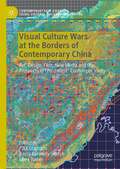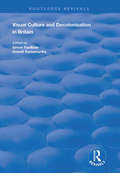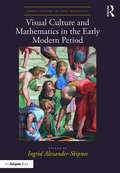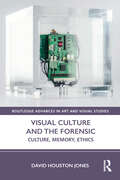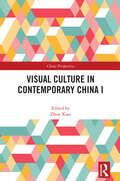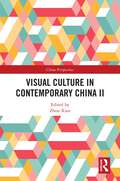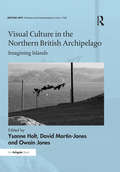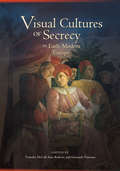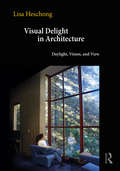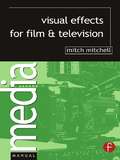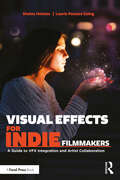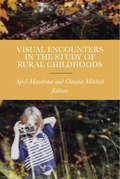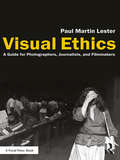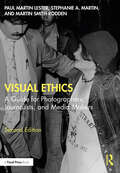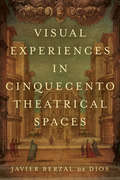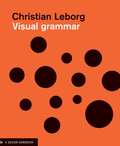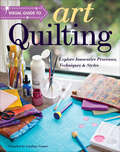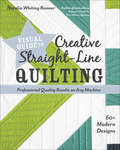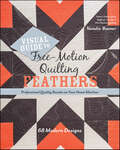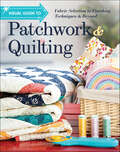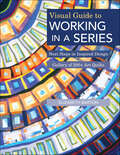- Table View
- List View
Visual Culture Wars at the Borders of Contemporary China: Art, Design, Film, New Media and the Prospects of “Post-West” Contemporaneity (Contemporary East Asian Visual Cultures, Societies and Politics)
by Paul Gladston Beccy Kennedy-Schtyk Ming TurnerThis edited collection brings together essays that share in a critical attention to visual culture as a means of representing, contributing to and/or intervening with discursive struggles and territorial conflicts currently taking place at and across the outward-facing and internal borders of the People’s Republic of China. Elucidated by the essays collected here for the first time is a constellation of what might be described as visual culture wars comprising resistances on numerous fronts not only to the growing power and expansiveness of the Chinese state but also the residues of a once pervasively suppressive Western colonialism/imperialism. The present volume addresses visual culture related to struggles and conflicts at the borders of Hong Kong, the South China Sea and Taiwan as well within the PRC with regard the so-called “Great Firewall of China” and differences in discursive outlook between China and the West on the significances of art, technology, gender and sexuality. In doing so, it provides a vital index of twenty-first century China’s diversely conflicted status as a contemporary nation-state and arguably nascent empire.
Visual Culture and Decolonisation in Britain (Routledge Revivals)
by Anandi RamamurthyFirst published in 2006, this volume provides the first in-depth analysis of the place of visual representations within the process of decolonisation during the period 1945 to 1970. The chapters trace the way in which different visual genres – art, film, advertising, photography, news reports and ephemera – represented and contributed to the political and social struggles over Empire and decolonisation during the mid-Twentieth century. The book examines both the direct visual representation of imperial retreat after 1945 as well as the reworkings of imperial and ‘racial’ ideologies within the context of a transformed imperialism. While the book engages with the dominant archive of artists, exhibitions, newsreels and films, it also explores the private images of the family album as well as examining the visual culture of anti-colonial resistance.
Visual Culture and Mathematics in the Early Modern Period (Visual Culture in Early Modernity)
by Ingrid Alexander-SkipnesDuring the early modern period there was a natural correspondence between how artists might benefit from the knowledge of mathematics and how mathematicians might explore, through advances in the study of visual culture, new areas of enquiry that would uncover the mysteries of the visible world. This volume makes its contribution by offering new interdisciplinary approaches that not only investigate perspective but also examine how mathematics enriched aesthetic theory and the human mind. The contributors explore the portrayal of mathematical activity and mathematicians as well as their ideas and instruments, how artists displayed their mathematical skills and the choices visual artists made between geometry and arithmetic, as well as Euclid’s impact on drawing, artistic practice and theory. These chapters cover a broad geographical area that includes Italy, Switzerland, Germany, the Netherlands, France and England. The artists, philosophers and mathematicians whose work is discussed include Leon Battista Alberti, Nicholas Cusanus, Marsilio Ficino, Francesco di Giorgio, Leonardo da Vinci and Andrea del Verrocchio, as well as Michelangelo, Galileo, Piero della Francesca, Girard Desargues, William Hogarth, Albrecht Dürer, Luca Pacioli and Raphael.
Visual Culture and Pandemic Disease Since 1750: Capturing Contagion (Science and the Arts since 1750)
by Marsha Morton Ann-Marie AkehurstThrough case studies, this book investigates the pictorial imaging of epidemics globally, especially from the late eighteenth century through the 1920s when, amidst expanding Western industrialism, colonialism, and scientific research, the world endured a succession of pandemics in tandem with the rise of popular visual culture and new media. Images discussed range from the depiction of people and places to the invisible realms of pathogens and emotions, while topics include the messaging of disease prevention and containment in public health initiatives, the motivations of governments to ensure control, the criticism of authority in graphic satire, and the private experience of illness in the domestic realm. Essays explore biomedical conditions as well as the recurrent constructed social narratives of bias, blame, and othering regarding race, gender, and class that are frequently highlighted in visual representations. This volume offers a pictured genealogy of pandemic experience that has continuing resonance. The book will be of interest to scholars working in art history, visual studies, history of medicine, and medical humanities.
Visual Culture and the Forensic: Culture, Memory, Ethics (Routledge Advances in Art and Visual Studies)
by David Houston JonesDavid Houston Jones builds a bridge between practices conventionally understood as forensic, such as crime scene investigation, and the broader field of activity which the forensic now designates, for example in performance and installation art, as well as photography. Contemporary work in these areas responds both to forensic evidence, including crime scene photography, and to some of the assumptions underpinning its consumption. It asks how we look, and in whose name, foregrounding and scrutinising the enduring presence of voyeurism in visual media and instituting new forms of ethical engagement. Such work responds to the object-oriented culture associated with the forensic and offers a reassessment of the relationship of human voice and material evidence. It displays an enduring debt to the discursive model of testimony which has so far been insufficiently recognised, and which forms the basis for a new ethical understanding of the forensic. Jones’s analysis brings this methodology to bear upon a strand of contemporary visual activity which has the power to significantly redefine our understandings of the production, analysis and deployment of evidence. Artists examined include Forensic Architecture, Simon Norfolk, Melanie Pullen, Angela Strassheim, John Gerrard, Julian Charrière, Trevor Paglen, Laura Poitras and Sophie Ristelhueber. The book will be of interest to scholars working in art history, visual culture, literary studies, modern languages, photography and critical theory.
Visual Culture in Contemporary China
by Xiaobing TangExploring a wealth of images ranging from woodblock prints to oil paintings, this beautifully illustrated full-color study takes up key elements of the visual culture produced in the People's Republic of China from its founding in 1949 to the present day. In a challenge to prevailing perceptions, Xiaobing Tang argues that contemporary Chinese visual culture is too complex to be understood in terms of a simple binary of government propaganda and dissident art, and that new ways must be sought to explain as well as appreciate its multiple sources and enduring visions. Drawing on rich artistic, literary, and sociopolitical backgrounds, Tang presents a series of insightful readings of paradigmatic works in contemporary Chinese visual arts and cinema. Lucidly written and organized to address provocative questions, this compelling study underscores the global and historical context of Chinese visual culture and offers a timely new perspective on our understanding of China today.
Visual Culture in Contemporary China I (China Perspectives)
by Zhou XianAs the first volume of a two-volume set that examines the interaction between social transformation and visual culture in contemporary China, this book explores the visual construction of popular culture, avant-garde art, and grassroots media culture. Drawing on an approach of Marxist historic materialism and academic resources of sociology, communication, and art, this study of contemporary China’s visual culture emphasizes two inter-related aspects – the visual construction of society and the social construction of the visual. It seeks to unravel how visual culture is produced and constructed, as well as how it reflects the profound social transformation and reshapes people’s understanding and experience of modernization. In this volume, the contributors revisit popular culture, avant-garde art, and grassroots media culture in contemporary China, analyzing the visual image and representation, and visual culture’s role in social construction. In doing so, the book also reveals the cultural tension of contemporary China, in which the visual aspect figures prominently. This book will serve as an essential read for scholars and students of China studies and cultural studies, as well as all levels of readers interested in visual culture in contemporary China.
Visual Culture in Contemporary China II (China Perspectives)
by Zhou XianThe second in a two-volume series that explores the interplay between social transformation and visual culture in contemporary China, this book examines the profound changes in the cityscapes, visual regimes, and visual technologies that shape the aestheticization of everyday life.Drawing on an approach of Marxist historical materialism and interdisciplinary resources from sociology, communication, and art, this volume investigates three key aspects of visual culture in modern China: the transformation of urban landscapes and its impact on cultural autonomy and local identity; the development of visual regimes, focusing on public museums as sites for the construction of public visuality; and the role of visual technologies in reshaping everyday life, from the influence of television on traditional customs to the rise of internet subcultures.This title will provide valuable insights for scholars and students of Chinese, cultural, and urban studies, as well as readers interested in the ongoing visual transformation of contemporary Chinese society.
Visual Culture in the Northern British Archipelago: Imagining Islands (British Art: Histories and Interpretations since 1700)
by David Martin-Jones Owain Jones Ysanne HoltThis edited collection, including contributors from the disciplines of art history, film studies, cultural geography and cultural anthropology, explores ways in which islands in the north of England and Scotland have provided space for a variety of visual-cultural practices and forms of creative expression which have informed our understanding of the world. Simultaneously, the chapters reflect upon the importance of these islands as a space in which, and with which, to contemplate the pressures and the possibilities within contemporary society. This book makes a timely and original contribution to the developing field of island studies, and will be of interest to scholars studying issues of place, community and the peripheries.
Visual Cultures of Secrecy in Early Modern Europe (Early Modern Studies #11)
by William Eamon Giancarlo Fiorenza Patricia Simons Maria Ruvoldt Henry Dietrich Fernández Allie Terry-FritschSecrets in all their variety permeated early modern Europe, from the whispers of ambassadors at court to the emphatically publicized books of home remedies that flew from presses and booksellers’ shops. This interdisciplinary volume draws on approaches from art history and cultural studies to investigate the manifestations of secrecy in printed books and drawings, staircases and narrative paintings, ecclesiastical furnishings and engravers’ tools. Topics include how patrons of art and architecture deployed secrets to construct meanings and distinguish audiences, and how artists and patrons manipulated the content and display of the subject matter of artworks to create an aura of exclusive access and privilege. Essays examine the ways in which popes and princes skillfully deployed secrets in works of art to maximize social control, and how artists, printers, and folk healers promoted their wares through the impression of valuable, mysterious knowledge.The authors contributing to the volume represent both established authorities in their field as well as emerging voices. This volume will have wide appeal for historians, art historians, and literary scholars, introducing readers to a fascinating and often unexplored component of early modern culture.
Visual Cultures of Secrecy in Early Modern Europe (Early Modern Studies)
by William Eamon Giancarlo Fiorenza Patricia Simons Maria Ruvoldt Henry Dietrich Fernández Allie Terry-Fritsch Lyle MasseySecrets in all their variety permeated early modern Europe, from the whispers of ambassadors at court to the emphatically publicized books of home remedies that flew from presses and booksellers’ shops. This interdisciplinary volume draws on approaches from art history and cultural studies to investigate the manifestations of secrecy in printed books and drawings, staircases and narrative paintings, ecclesiastical furnishings and engravers’ tools. Topics include how patrons of art and architecture deployed secrets to construct meanings and distinguish audiences, and how artists and patrons manipulated the content and display of the subject matter of artworks to create an aura of exclusive access and privilege. Essays examine the ways in which popes and princes skillfully deployed secrets in works of art to maximize social control, and how artists, printers, and folk healers promoted their wares through the impression of valuable, mysterious knowledge.The authors contributing to the volume represent both established authorities in their field as well as emerging voices. This volume will have wide appeal for historians, art historians, and literary scholars, introducing readers to a fascinating and often unexplored component of early modern culture.
Visual Delight in Architecture: Daylight, Vision, and View
by Lisa HeschongVisual Delight in Architecture examines the many ways that our lives are enriched by the presence of natural daylight and window views within our buildings. It makes a compelling case that daily exposure to the rhythms of daylight is essential to our health and well-being, tied to the very genetic foundations of our physiology and cognitive function. It describes all the subtlety, beauty, and pleasures of well-daylit spaces and attractive window views, and explains how these are woven into the fabric of both our everyday sensory experience and enduring cultural perspectives. All types of environmental designers, along with anyone interested in human health and well- being, will fi nd new insights offered by Visual Delight in Architecture. The book is both accessible and provocative, full of personal stories and persuasive research, helping designers to gain a deeper understanding of the scientific basis of their designs, scientists to better grasp the real-world implications of their work, and everyone to more fully appreciate the role of windows in their lives.
Visual Effects for Film and Television (Media Manual Ser.)
by Mitch Mitchell* An invaluable insight into the use of visual effects in film and television* Fully illustrated with diagrams to show you step-by-step techniques* Covers visual effects processes from front-of-camera to post-production* Integrated approach to film, video and digital techniques* Redefines the rules of photography so that they can be broken for effects* Shows the line of development from the oldest to the newest processes* A must for cinematographers, editors, designers and students of VFX alike * Everything you need to know to plan and supervise visual effects shots* Essential reading for anyone working in commercials/advertising photography or effectsWritten by an experienced professional, this manual is the essential guide to understanding the principles and background of modern visual effects.Visual effects are at the forefront of a digital revolution in the film and video industry and are becoming more and more important to movie language. This book teaches the practical techniques and skills required to incorporate effects successfully into both film and television production.
Visual Effects for Indie Filmmakers: A Guide to VFX Integration and Artist Collaboration
by Shaina Holmes Laurie Powers GoingThis book provides independent filmmakers and VFX artists with tools to work collaboratively and effectively on their low-budget films. Experts Shaina Holmes and Laurie Powers Going define common VFX needs and demystify the process of incorporating VFX into all stages of production. The book covers every step of the process, including when to consider using VFX, basics of 2D and 3D methodology, budgeting, virtual production, on-set supervision, and more. It provides tips and tricks to common VFX questions, such as color management and file types, along with practical solutions for the production team while on-set working with VFX scenes. The incorporation of testimonials from indie filmmakers and VFX/post production professionals brings a voice to both sides of the table and provides real-world scenarios for the techniques described. The book offers realistic lower-budget alternative solutions to achieving big-budget vision. This book is ideal for students on a micro budget and independent filmmakers on low to mid budgets working with visual effects for photorealistic film, TV, and short-form projects.
Visual Encounters in the Study of Rural Childhoods
by Claudia Mitchell Eric Gottesman Naydene De Lange Relebohile Moletsane April Mandrona Bernard Chan Karren Eppley Wendy Ewald Sally Campbell Galman Diana Carolina Gomez Helle Stranfaard Jensen Renee Jackson Rahul Kamble Irina Kosterina Jonathan Kremser Barbara Turk Niskac Sara Nyhlen Katarina Gritli Nygren Katja Gillander-Gadin Eva Soderberg Kelly Royds Beth Shively Jennifer Vanderburgh Sheilah Wilson Holley WlodarczykVisual Encounters in the Study of Rural Childhoods brings together visual studies and childhood studies to explore images of childhood in the study of rurality and rural life. The volume highlights how the voices of children themselves remain central to investigations of rural childhoods. Contributions look at representations and experiences of rural childhoods from both the Global North and Global South (including U.S., Canada, Haiti, India, Sweden, Slovenia, South Africa, Russia, Timor-Leste, and Colombia) and consider visuals ranging from picture books to cell phone video to television.
Visual Ethics: A Guide for Photographers, Journalists, and Filmmakers
by Paul Martin LesterVisual Ethics addresses the need for critical thinking and ethical behavior among professionals responsible for visual messages in photography and photojournalism, film, and digital media. From the author of Photojournalism: An Ethical Approach, published more than 20 years ago, this book goes beyond photojournalism ethics. It discusses crucial contemporary concerns, including persuasion, stereotyping, global perspectives, graphic design decisions, multimedia production, social media, and more. Written for an ever-growing discipline, author Paul Martin Lester gives serious ethical consideration to the complex field of visual communication.
Visual Ethics: A Guide for Photographers, Journalists, and Media Makers
by Paul Martin Lester Stephanie A. Martin Martin Smith-RoddenAn indispensable guide to visual ethics, this book addresses the need for critical thinking and ethical behavior among students and professionals responsible for a variety of mass media visual messages. Written for an ever-growing discipline, authors Paul Martin Lester, Stephanie A. Martin, and Martin Rodden-Smith give serious ethical consideration to the complex field of visual communication. The book covers the definitions and uses of six philosophies, analytical methods, cultural awareness, visual reporting, documentary, citizen journalists, advertising, public relations, typography, graphic design, data visualizations, cartoons, motion pictures, television, computers and the web, augmented and virtual reality, social media, the editing process, and the need for empathy. At the end of each chapter are case studies for further analysis and interviews with thoughtful practitioners in each field of study, including Steven Heller and Nigel Holmes. This second edition has also been fully revised and updated throughout to reflect on the impact of new and emerging technologies. This book is an important resource for students of photojournalism, photography, filmmaking, media and communication, and visual communication, as well as professionals working in these fields.
Visual Ethics: A Guide for Photographers, Journalists, and Media Makers
by Paul Martin Lester Stephanie A. Martin Martin Smith-RoddenAn indispensable guide to visual ethics, this book addresses the need for critical thinking and ethical behavior among students and professionals responsible for a variety of mass media visual messages.Written for an ever-growing discipline, authors Paul Martin Lester, Stephanie A. Martin, and Martin Rodden-Smith give serious ethical consideration to the complex field of visual communication. The book covers the definitions and uses of six philosophies, analytical methods, cultural awareness, visual reporting, documentary, citizen journalists, advertising, public relations, typography, graphic design, data visualizations, cartoons, motion pictures, television, computers and the web, augmented and virtual reality, social media, the editing process, and the need for empathy. At the end of each chapter are case studies for further analysis and interviews with thoughtful practitioners in each field of study, including Steven Heller and Nigel Holmes. This second edition has also been fully revised and updated throughout to reflect on the impact of new and emerging technologies.This book is an important resource for students of photojournalism, photography, filmmaking, media and communication, and visual communication, as well as professionals working in these fields.
Visual Experiences in Cinquecento Theatrical Spaces (Toronto Italian Studies)
by Javier Berzal de DiosThrough an interdisciplinary examination of sixteenth-century theatrical spaces, Visual Experiences in Cinquecento Theatrical Spaces studies the performative aspects of the early modern stage, paying special attention to the overlooked complexities of audience experience. Examining the period’s philosophical and aesthetic ideas about space, place, and setting, the book shows how artists consciously moved away from traditional representations of real spaces on stages to conjure spectacles that pushed their collective audiences towards more imaginative, collaborative engagements no longer tethered to strict definitions of naturalism. In this way, Visual Experiences breaks with traditional interpretations of early modern staging techniques, arguing that the goal of early modern artists was not the creation of a naturalistically unified stage constructed for a single, privileged viewer, but rather a complex multimedia experience addressing a diverse set of viewers. In stressing the wider scenographic possibilities of the sixteenth-century stage, the book focuses on how space created various modes of audience engagement.
Visual Grammar
by Christian LeborgLeborg (founder of K, "a knowledge and communications consultancy in Oslo, Norway") presents a primer and grammatical dictionary of elements of visual communication found in graphic design. The volume covers abstract objects and structures such as dimension, format and volume; concrete objects and structures including form, size, color, and texture; activities such as repetition and mirroring; and relations between several objects in a composition by pairing illustrative drawings with brief textual definitions.
Visual Guide to Art Quilting: Explore Innovative Processes, Techniques & Styles
by Lindsay ConnerThis visual reference will help anyone inspired to make art quilts gain the practical tools and inspiration necessary to translate your ideas to fabric. Start on the path to art quilting success! For anyone inspired to make art quilts, this visual reference includes step-by-step photos and illustrations to guide you on your creative journey. Dip your toes in the water with an introduction from some of the biggest names in quilting arts to design theory, supplies and tools, and working with fabric. Practice surface design, embellishment, and quilting by hand and machine as you learn a variety of finishing techniques to turn your unique ideas and imagery into art quilts. • Expand your art quilter&’s toolbox with helpful lessons, plus step-by-step photos and illustrations • Study dyeing and printing on fabrics, embellishment, quilting, and working in a series • Gain the practical tools and inspiration you need to finally translate your ideas to fabric
Visual Guide to Creative Straight-Line Quilting: Professional-Quality Results on Any Machine
by Natalia Whiting BonnerDiscover how to machine quilt using straight lines with one of 48 quilting ideas and 13 variations, from the author of Modern One-Block Quilts.Are feathers and swirls your fallback? Learn how satisfying it is to quilt with only straight lines! Quilting expert Natalia Bonner shares sixty new straight-line motifs to fill in triangles, square blocks, and borders, plus allover designs. Teach your walking foot some new tricks or practice controlled free-motion quilting with rulers. Domestic or longarm machine . . . the choice is yours! Each pattern comes with step-by-step photos, so quilters of all levels can conquer their fears of straight-line quilting, and learn to rock it!• Natalia Bonner fans, unite! Learn forty-eight straight-line quilting ideas and thirteen fun variations• Find freedom in the constraints of straight-line quilting and shine a spotlight on every intriguing angle• Use a longarm or home sewing machine to create geometric perfection, step-by-step
Visual Guide to Free-Motion Quilting Feathers: Professional Quality Results on Your Home Machine
by Natalia BonnerPut a feather in your quilting cap Take the fear out of quilting feathers! Explore 68 modern feather designs with step-by-step guidance from award-winning quilter Natalia Bonner. Quilt stunning feathers on a variety of blocks and borders with this beginner-friendly, visual guide. Unlike traditional feather quilting, which relies on exactness and precision, Natalia’s ideas will help you break away from perfection and find creativity in your quilting practice. Use your home sewing machine or a longarm to free-motion feathers with confidence, adding a truly elegant finish to today’s modern quilts. • 68 modern feather designs! Beginner-friendly techniques from best-selling author Natalia Bonner • Kick your feather fears to the curb with an easy-to-use guide for domestic and longarm quilters • Finish blocks and borders with unique feather motifs to complement today’s modern quilts
Visual Guide to Patchwork & Quilting: Fabric Selection to Finishing Techniques & Beyond
by C&T PublishingYour one-stop shop for everything quilting! Absorb the knowledge of more than 20 quilt experts in one place! With hundreds of photographs and illustrations to help you plan your quilting projects, this comprehensive guide answers all of your quiltmaking questions. Included in this comprehensive reference guide: fabric 101; piecing and applique by hand and machine; understanding color, value, and quilt design; start-to-finish quilt construction; quilting motifs, tips, and tricks; beyond the basics; plus a handy index. It's the must-have book for any quilter! • A quilter's complete handbook with 25 block patterns and projects galore • Learn rotary cutting, pressing, piecing, and applique, as well as advanced techniques like quilt-as-you-go, crazy quilting, and more • Pick the right supplies, tools, and fabric every time! All about precuts, colors, and quilt design basics • Finish your quilt like a pro, from the "quilt sandwich" to hand- and machine-quilting motifs to binding
Visual Guide to Working in a Series: Next Steps in Inspired Design
by Elizabeth BartonDeepen your quilt artistry by creating quilts in a series This inspiring guide from art quilter Elizabeth Barton is for quilt artists who have mastered the basics and want to explore deeper levels of creativity and skill. Learn how making a series of quilts can help you generate more ideas, find new subtleties in favorite subjects, and build a body of work for shows. Packed with hands-on lessons and examples, this book will transform your work and enlarge your creative vision forever. • Creative exercises help you develop your own themes and techniques • Includes huge gallery of more than 200 examples from Elizabeth and other working art quilters • Explains how working in a series elevates creativity and artistic depth
